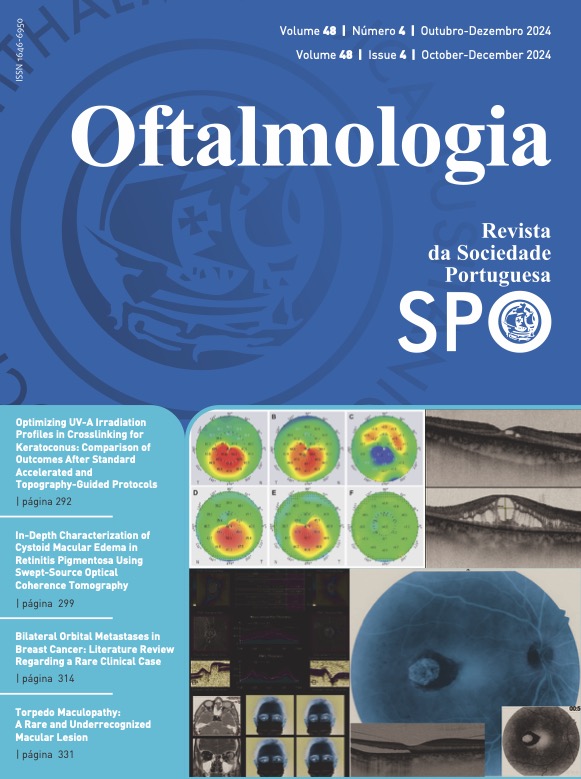Dome and Ridge-Shaped Macula Angle and its Association with Subretinal Fluid
DOI:
https://doi.org/10.48560/rspo.33275Keywords:
Myopia, Subretinal Fluid, Tomography, Optical Coherence, Choroid, Macula Lutea, Visual AcuityAbstract
INTRODUCTION: Dome and ridge-shaped macula (DSM and RSM) are defined by a bulge of retinal pigment epithelium (RPE), choroid, and sclera of more than 50 μm in height above a line connecting the RPE on both sides, in an optical coherence tomography exam (OCT). RSM is defined by a macular elevation only in one meridian across the fovea, whereas the DSM has an elevation in both horizontal and vertical meridians. Their pathogenesis remains controversial. The purpose of this study is to compare OCT parameters in eyes with DSM and RSM with and without subretinal fluid (SRF).METHODS: A retrospective, single-center study was conducted in Centro Hospitalar Universitário de São João (Porto, Portugal). Data collected included age at diagnosis, the affected eye, type of bulge (DSM or RSM), best corrected visual acuity (BVCA), spherical equivalent, intraocular pressure (IOP), subfoveal choroidal thickness (SCT), DSM and RSM angle, and complications.
RESULTS: Fifty eyes from 27 patients were evaluated. Twenty-three patients were female (85.19%) and the mean patient age was 53.1 years (range 20–90 years). The condition was bilateral in 23 patients (85.19%). Twenty eyes were identified as RSM and 24 eyes as DSM. In the remaining 6 eyes only, horizontal scans were performed. The mean spherical equivalent was not statistically different between the group without SRF and the group with SRF (-11.8±6.7 D vs -7.5±6.4 D, p=0.059). No significant difference was observed in the IOP between both groups (p=0.458). The mean SCT was higher in eyes with SRF (129.44±125.96 μm vs 233.63±99.18 μm, p=0.006). DSM/RSM angle was positively correlated to the SRF area (p=0.026) but no significant correlation was found between SCT and the SRF area (p=0.759). The proportion of eyes with SRF was not different between eyes with DSM and RSM (p =0.601). The following complications were found: SRF (N=16), epiretinal membrane (N=9), macular neovascularization (N=8), retinoschisis (N=4), and macular pseudohole (N=3).
CONCLUSION: Eyes with DSM/RSM complicated with SRF have a greater SCT. DSM/RSM angle may be a useful OCT marker when evaluating patients with DMS/RSM as it seems to be associated with more SRF.
Downloads
References
Gaucher D, Erginay A, Lecleire-Collet A, Haouchine B, Puech M, Cohen SY, et al. Dome-Shaped Macula in Eyes with Myopic Posterior Staphyloma. Am J Ophthalmol. 2008;145(5).
Xu X, Fang Y, Jonas JB, Du R, Shinohara K, Tanaka N, et al. RIDGE-SHAPED MACULA IN YOUNG MYOPIC PATIENTS AND ITS DIFFERENTIATION FROM TYPICAL DOME-SHAPED MACULA IN ELDERLY MYOPIC PATIENTS. Vol. 00, RETINA. 2018.
Mehdizadeh M, Nowroozzadeh M. Dome-shaped macula in eyes with myopic posterior staphyloma. Am J Ophthalmol 2008 Sep;146(3):478; author reply 478-9.
Imamura Y, Iida T, Maruko I, Zweifel SA, Spaide RF. Enhanced depth imaging optical coherence tomography of the sclera in dome-shaped macula. Am J Ophthalmol. 2011 Feb;151(2):297–302.
Errera MH, Michaelides M, Keane PA, Restori M, Paques M, Moore AT, et al. The extended clinical phenotype of dome-shaped macula. Graefe’s Archive for Clinical and Experimental Ophthalmology. 2014;252(3):499–508.
Ohno-Matsui K, Wu PC, Yamashiro K, Vutipongsatorn K, Fang Y, Cheung CMG, et al. IMI pathologic myopia. Vol. 62, Investigative Ophthalmology and Visual Science. Association for Research in Vision and Ophthalmology Inc.; 2021.
Flitcroft DI, He M, Jonas JB, Jong M, Naidoo K, Ohno-Matsui K, et al. IMI – Defining and classifying myopia: A proposed set of standards for clinical and epidemiologic studies. Invest Ophthalmol Vis Sci. 2019 Feb 1;60(3):M20–30.
Caillaux V, Gaucher D, Gualino V, Massin P, Tadayoni R, Gaudric A. Morphologic characterization of dome-shaped macula in myopic eyes with serous macular detachment. Am J Ophthalmol. 2013;156(5).
García-Zamora M, Flores-Moreno I, Ruiz-Medrano J, Vega-González R, Puertas M, Almazán-Alonso E, et al. Dome-shaped macula versus ridge-shaped macula eyes in high myopia based on the 12-line radial optical coherence tomography scan pattern. Differences in clinical features. Diagnostics. 2021 Oct 1;11(10).
Lorenzo D, Arias L, Choudhry N, Millan E, Flores I, Rubio MJ, et al. DOME-SHAPED MACULA IN MYOPIC EYES Twelve-Month Follow-up. Vol. 37, RETINA. 2017.
Negrier P, Couturier A, Gaucher D, Touhami S, Le Guern G, Tadayoni R, et al. Choroidal thickness and vessel pattern in myopic eyes with dome-shaped macula. British Journal of Ophthalmology. 2021 Jun 28;106(12):1730–5.
Muhiddin HS, Mayasari AR, Umar BT, Sirajuddin J, Patellongi I, Islam IC, et al. Choroidal thickness in correlation with axial length and myopia degree. Vision. 2022;6:16. doi: 10.3390/vision6010016.
Downloads
Published
How to Cite
Issue
Section
License
Copyright (c) 2024 Revista Sociedade Portuguesa de Oftalmologia

This work is licensed under a Creative Commons Attribution-NonCommercial 4.0 International License.
Do not forget to download the Authorship responsibility statement/Authorization for Publication and Conflict of Interest.
The article can only be submitted with these two documents.
To obtain the Authorship responsibility statement/Authorization for Publication file, click here.
To obtain the Conflict of Interest file (ICMJE template), click here





